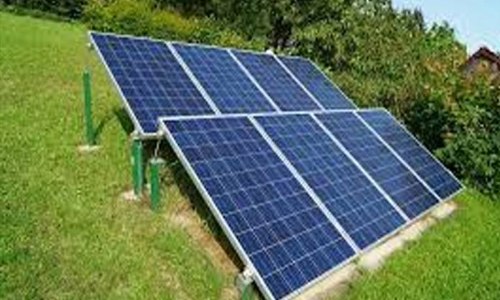Live
- Prakasam police rescues kidnapped toddler within hours
- Time to get rid of Sattavad and Parivarvad politics
- Extend neither spl nor ill treatment
- Must-Watch OTT Originals in 2024: The Year’s Best Shows and Movies
- 40 Indian startups secure over $787 mn in a week
- India now formidable force on chess board
- Raghavendra Mutt pontiff visits Tirumala
- Whistleblower of OpenAI found dead in US apartment
- Trump’s US-first policy & India’s strategic latitude
- Chandrababu pays tribute to Potti Sriramulu and Sardar Vallabhbhai Patel
Just In

Scientists have designed a metal frame that increases the amount of sunlight captured by a solar cell, enhancing its energy production by almost onethird
New York: Scientists have designed a metal frame that increases the amount of sunlight captured by a solar cell, enhancing its energy production by almost one-third.
The simple, inexpensive and ingenious method could increase solar energy captured for people in developing countries, as well as remote regions that are off the grid, researchers said. "In Uganda, between 20 to 25 per cent of people have no access to electricity," said Beth Parks, an associate professor at Colgate University in the US. "One solar cell supplies enough energy to power lights and charge cell phones and radios. This is a huge quality-of-life improvement," said Parks.
While solar panels offer a clean source of renewable energy, they are typically mounted on a fixed frame and only optimally oriented towards the sun during specific hours of the day. Parks previously saw a design for a frame that would allow the solar panel to track the sun using hanging weights. However, the design had not been tested to see how it actually performed. Nor had it been optimised for affordability to ensure commercial viability and adoption.
Parks worked with students at the Mbarara University of Science and Technology in Uganda to design a frame using metal tubing that a local welder could easily obtain and assemble. "We have created a frame using inexpensive materials that allows the solar panels to track the arc of the sun throughout the day," Parks said. "This approach could make solar energy more affordable to households and small businesses in the developing world," she said. In her design, a bucket of rocks is placed on the west side of the frame and a bucket of water is placed on the east side.
Using a controlled leak from the water bucket, the weight shifts and the panel slowly rotates from east to west throughout the day. Parks and her team tested the design on 20 random days in Uganda. The solar cell on the movable frame captured 30 per cent more sunlight than the stationary solar cell at the same location. "If this frame is adopted, it has the potential to create a small industry for the local community," Parks said. According to Parks, the cost of the system -- the solar cell, battery, charger and frame -- is about 10 per cent less than a comparable rooftop solar cell system.

© 2024 Hyderabad Media House Limited/The Hans India. All rights reserved. Powered by hocalwire.com







